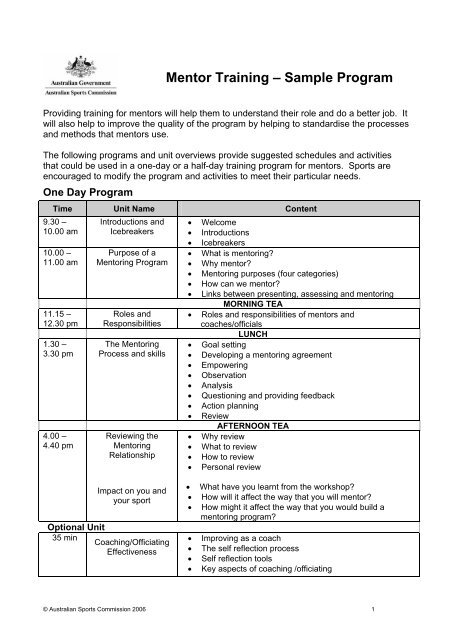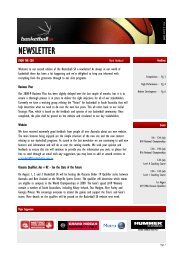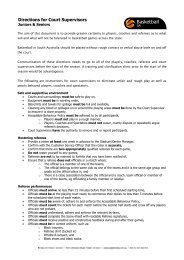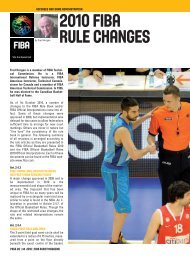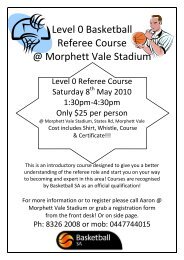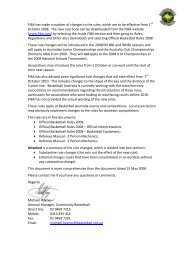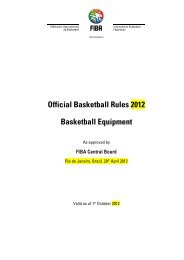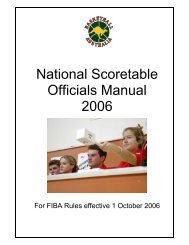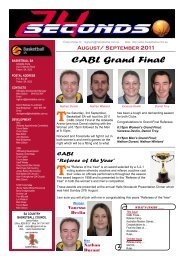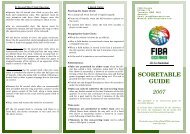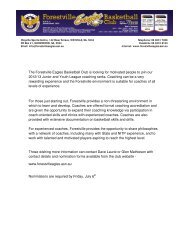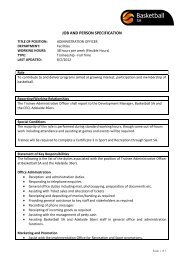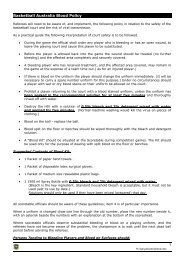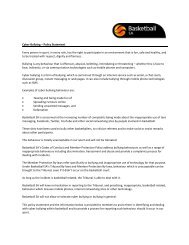Mentor Training â Sample Program - Basketball SA
Mentor Training â Sample Program - Basketball SA
Mentor Training â Sample Program - Basketball SA
- No tags were found...
You also want an ePaper? Increase the reach of your titles
YUMPU automatically turns print PDFs into web optimized ePapers that Google loves.
<strong>Mentor</strong> <strong>Training</strong> – <strong>Sample</strong> <strong>Program</strong>Providing training for mentors will help them to understand their role and do a better job. Itwill also help to improve the quality of the program by helping to standardise the processesand methods that mentors use.The following programs and unit overviews provide suggested schedules and activitiesthat could be used in a one-day or a half-day training program for mentors. Sports areencouraged to modify the program and activities to meet their particular needs.One Day <strong>Program</strong>Time Unit Name Content9.30 –10.00 am10.00 –11.00 am11.15 –12.30 pm1.30 –3.30 pm4.00 –4.40 pmIntroductions andIcebreakersPurpose of a<strong>Mentor</strong>ing <strong>Program</strong>Roles andResponsibilitiesThe <strong>Mentor</strong>ingProcess and skillsReviewing the<strong>Mentor</strong>ingRelationship• Welcome• Introductions• Icebreakers• What is mentoring?• Why mentor?• <strong>Mentor</strong>ing purposes (four categories)• How can we mentor?• Links between presenting, assessing and mentoringMORNING TEA• Roles and responsibilities of mentors andcoaches/officialsLUNCH• Goal setting• Developing a mentoring agreement• Empowering• Observation• Analysis• Questioning and providing feedback• Action planning• ReviewAFTERNOON TEA• Why review• What to review• How to review• Personal reviewImpact on you andyour sportOptional Unit35 minCoaching/OfficiatingEffectiveness• What have you learnt from the workshop?• How will it affect the way that you will mentor?• How might it affect the way that you would build amentoring program?• Improving as a coach• The self reflection process• Self reflection tools• Key aspects of coaching /officiating© Australian Sports Commission 2006 1
Half Day <strong>Program</strong>Time9.00 –9.159.15 –10.1510.15 –10.3010.30 –12.30Unit NameIntroductions andIcebreakersRoles andResponsibilities of<strong>Mentor</strong>s andCoaches/OfficialsandThe <strong>Mentor</strong>ingProcess<strong>Mentor</strong>ing SkillsContent• Welcome• Introductions• Icebreakers• Links between presenting, assessing andmentoring• The mentoring process¬ Goal setting and agreements¬ Empowering¬ Observation and analysis¬ Questioning and providing feedback¬ Action planning¬ Reviewing the relationship• Roles and responsibilities of mentors andmenteesMORNING TEA• Goal setting• Empowerment• Observation• Questioning• FeedbackNote: Unit overviews for the half-day program have not been provided. Presenters areadvised to adapt the unit overview for the full-day program, by shortening ordeleting some activities.© Australian Sports Commission 2006 2
Unit OverviewsIntroductions and IcebreakersTime Content Activities and PowerPoint slides5 min • Introduce self and welcomeparticipants• Overview workshop and set themood• Remember: <strong>Mentor</strong>ing is about being a supportive friend. Ensure your style as apresenter models this philosophy.10 min • Icebreaker Activity 1 • Conduct a fun icebreaker that will help people to introduce themselves and sets the toneof the workshop as an active and participatory one.10 min • Icebreaker Activity 2 • Get participants to think of someone who acted as a mentor for them (not necessarily insport – could be in work or personal life).• Distribute attached ‘Qualities of <strong>Mentor</strong>s’ worksheet• Ask them to write down 2 qualities of the mentor that they admired and that helped themto learn.• Ask participants to reflect on how they would like to be viewed as a mentor and writedown 2 qualities that they would like to be remembered for as a mentor.• Share some of these qualities as a large group.• Explain that learning to be a good mentor is a long process. This workshop will providesome of the skills, but many will have to be learnt ‘on the job’, with the coaches/officialsyou mentor.5 mins(optional)Total Time = 30 min• Outline optional assessment • Assessment may be offered in some courses. Presenters should outline details of howassessment will occur.• Assessment is optional.© Australian Sports Commission 2006 3
Qualities of <strong>Mentor</strong>sThink of someone who acted as a mentor for you. This person could be someone fromyour sport, work or personal life. Think of someone who has inspired you, helped youdevelop a talent or showed an interest in you.1. Write down two qualities of this person that you admired and that helped you tolearn.2. Share some of these qualities with the rest of the group.3. Write down two qualities that you would like to be remembered for as a mentor.© Australian Sports Commission 2006 4
Purpose of a <strong>Mentor</strong>ing <strong>Program</strong>Time Content Activities and PowerPoint slides10 min • What is mentoring? • Group brainstorm on what is mentoring. Collate comments on board/butcher’s paper.• PowerPoint slide #2 – ‘Behind every successful person…’• PowerPoint slide #3 – ‘<strong>Mentor</strong> = a trusted friend or advisor’• Anecdote re the Greek legend of Telemachus who was cared for by <strong>Mentor</strong> while hisfather, Odysseus, fought in the Trojan War. <strong>Mentor</strong> acted as guardian, teacher, advisorand role model, so that Telemachus would attain the qualities and attributes essential forsucceeding his father as King of Ithaca.10 min • Why mentor? • Ask participants to work in pairs or small groups to brainstorm the benefits of mentoringfor:¬ the coaches/officials being mentored¬ the mentor¬ the club/sport• Collate some responses on a board/butcher’s paper under three headings.• Emphasise that mentoring doesn’t only benefit the coach/official being mentored andthat it should be a two way process.30 min • How can we mentor? • <strong>Mentor</strong>ing can occur in many different ways, both informally and formally.• PowerPoint slide #4 - <strong>Mentor</strong>ing Purposes¬ Professional DevelopmentThis applies to situations where a coach/official seeks to improve his or herskills and taps into the expertise of a mentor. It may well be complemented byformal study or personal reading and study. The emphasis is on being a bettercoach/official.¬ AccreditationThis is the situation where part of the accreditation process involves workingwith a mentor for the purpose of ensuring what is covered in a course can beapplied to a real life situation. It might involve a mentor giving feedback ontraining or assisting with a self-reflection process. It may or may not be tied toassessment.¬ UpdatingThis refers to the coach/official completing practical activity as an updatingrequirement. This requirement adds an extra dimension in that thecoach/official is not working alone but has the opportunity to receive feedback© Australian Sports Commission 2006 5
10 min • Links between presenting,mentoring and assessingand share ideas. It reinforces the concept of continuous learning for coachesand officials.¬ Fast TrackingTypically this is the retired athlete we want to groom for a coach/official role. Itis what often happens in high performance programs. The person undergoingthe fast tracking may do a variety of things to increase competence (do acourse, talk to others) and work with a mentor such as a head coach.• In small groups, discuss mentoring situations that occur in their sport, and consider therange of approaches to mentoring. Discuss the purpose of each of the mentoringprograms and try to classify them as professional development, accreditation, updatingor fast tracking.• Discuss the formality or informality of various mentoring relationships. Draw out theconclusion that mentoring can take many different forms and that mentoring programscan be designed in different ways to meet the different needs of each sport.• PowerPoint slide #5 – Roles in sport education.• Discuss the intertwined roles of sport educators.Total Time = 1 hr© Australian Sports Commission 2006 6
Roles and Responsibilities of <strong>Mentor</strong>s and Coaches/OfficialsTime Content Activities and PowerPoint slides40 min• Roles and • Break into small groups and brainstorm the roles and responsibilities of mentors and coaches/officials.responsibilities of Compare responses from the groups and summarise on butcher’s paper.mentors and • PowerPoint slide#6 – Some characteristics of a good mentorcoaches/officials • PowerPoint slide#7 – Some characteristics of a good coach or official (in a mentoring relationship)• Point out that the roles and responsibilities may vary from sport to sport and relationship torelationship, depending on the purpose of the mentoring program.• PowerPoint slide# 8 – <strong>Mentor</strong>ing Roles. Explain that mentors can play a variety of roles dependingof the needs of the coach/official at any given time. A good mentor will be able to switch betweenthese roles to suit the needs of the coach/officialCoach: Showing how to perform a task or activity. This role may use a variety of teaching methodssuch as inform, question, model and confirm.Facilitate: Creating opportunities for the coach/official to use new skills or suggesting ways thecoach/official can move toward their goals.Counsel: Help the mentor explore consequences of potential decisions or actions. The mentorshould listen, probe, clarify and provide advice when asked.Sponsor: Promote of refer the coach/official to others. Provide access to a wider networkSupport: Encourage the coach/official to grow by providing support, acceptance, inspiration,15 min • LinkingAssessment to<strong>Mentor</strong>ing15 mins • What Skills will<strong>Mentor</strong>s Need?5 mininspiration and challenge. Try to relate to the coach/official and share experiences.• Explain that some sports will have their mentors assess as part of their role• Brainstorm pros and cons and develop a list of how you can minimise the impact if you do need tohave mentors assessing their coach/official• PowerPoint slide # 9 – Pros and cons of mentors as assessors• PowerPoint slide # 10 – Strategies for mentors who are assessingBrainstorm - Skills for <strong>Mentor</strong>s• Have participants brainstorm some of the general skills a mentor may need• Discuss how mentoring skills overlap with the skills needed to present or assess• Explain that many roles that mentors pay may require specific skills and that mentors may need to betrained in some or all of these skills• .PowerPoint slide # 11– Skills <strong>Mentor</strong>s Require• Conclusion • Reinforce the importance of two-way communication and a willingness to learnTotal time = 1 hr and 15 min© Australian Sports Commission 2006 7
The <strong>Mentor</strong>ing Process and SkillsTime Content Activities and PowerPoint slides10 min • Overview the model forthe mentoring processo Set goalso Observeo Analyseo Provide feedbacko Action plan forimprovemento Review• PowerPoint slide # 12 – The <strong>Mentor</strong>ing Process• Note the similarities to the coaching process• PowerPoint slide # 13 – Foundations for successful mentoring relationships• The key to a successful mentoring relationship is to:¬ develop and communicate clear goals and expectations at the beginning of the relationship¬ set the ground rules and develop an agreement¬ clarify the roles of the mentor and the coach/official¬ work out when and how feedback will occur¬ review the relationship at regular intervals20 mins • Goal setting • PowerPoint slide # 14 - Goal setting• Goal setting is about analysing your strengths and weaknesses and developing strategies to improveyour performance.• Goal setting can be done on an informal or formal basis.• Informal goal setting may involve the mentor discussing with the coach/official what they hope tolearn from you. If the coach/official is unsure of what they hope to achieve, you can use questioning toestablish their strengths and weaknesses and narrow these down into specific goals and objectives.• Goal setting can also be done on a more formal basis. For example using a goal setting work sheet.Matching the mentor’s skills with what the coach/official wants to achieve is one of the keys to asuccessful relationship.• Goals need to be SMART.¬ Specific: Be specific about what you want to achieve. For example, if a coach/official says theywant to improve their coaching, help them to break this goal down into specific objectives &strategies¬ Measurable: How will you know when you have reached your goal?¬ Achievable & Realistic: Is the goal possible? For example, if a beginner official wants tobecome an international referee at the next Olympics and it usually takes someone 10 years toreach this, you need to be honest with your coach/official and guide them to a more achievableand realistic goal¬ Timebound: When do you want to achieve your goal?• PowerPoint slide # 15 - Two-way process of mentoring• <strong>Mentor</strong>ing is a two-way process and mutually beneficial for mentors and coaches/officials© Australian Sports Commission 2006 8
15 min • Setting ground rules anddeveloping anagreement• Ask a mentor and coach/official to share their goals with the group. This can be presented in person,on video or in written form. Discussion and questions about goal setting can be encouraged at thistime.• If you have been selected as a mentor in your sport, you probably have a number of other voluntaryroles like coaching, officiating, administration, assessing and/or competing. You therefore need toconsider what level of commitment and how much time you are prepared to give to your coach/official.• PowerPoint slide # 16 – Setting the ground rules• Setting some ground rules and developing an agreement at the beginning will prevent any problemsoccurring later• It is important to discuss with your coach/official when you will meet and how you will communicate. Isit OK for them to call you at midnight to discuss tactics for tomorrow’s game? Are you the sort ofperson who likes short, sharp feedback sessions or do you prefer in-depth discussions over lunch?What is the coach’s/official’s preferred learning style?• Formal agreements• developed by the mentor and coach/official which includes time and location of meetings as wellas agreed goals and outcomes for the relationship.• Informal agreement role play• Conduct an informal role play between two people to demonstrate setting goals and developingan agreement on an informal basis20 mins Empowerment • PowerPoint slide #17 - Empowerment: <strong>Mentor</strong>ing is a process…• PowerPoint slide #18 - Empowerment: Who is driving…? Emphasise that it is the coach/official,not the mentor who is responsible for driving the relationship.• PowerPoint slide #19 - Empowerment scenarios. Discuss the scenarios in small groups and workout your proposed solution. Report back to the bigger group.• PowerPoint slide #20 - Empowering the coach/official. This PowerPoint slide summarises somepractical things that the mentor can do to promote empowerment. Ask the group if there otheractions they can think of?10 mins Observation • Explain that observation can be a two way process, either with mentors observing the coach/officialin action and providing feedback, or with the coach/official observing the mentor in action, followed bya discussion about what the mentor did and why they did it• Discuss issues relating to observation. For example, when is it appropriate to observe, how to beunobtrusive, explaining the observation process to the athletes first, difficulties in observing via video(See following letters as an example of an interaction based on video observation).• PowerPoint slide # 21 - Observation checklist. Ask participants to work in pairs, with one acting asthe mentor and the other as the coach/official. In these pairs, discuss the sample observationchecklist provided on p.12. The person playing the role of the mentor should check if there are areas© Australian Sports Commission 2006 9
20 min25 minsQuestioning• Why use questions?• Types of questions• How to ask questionsFeedbackthat the coach/official would like specific feedback on (ie identify potential ‘weak areas’). Add anysport specific technical aspects to the checklist. Note: Remember this is just an observation checklistto help guide the mentor’s feedback to the coach/official. The checklist is not meant to be anassessment tool.• Point out that the checklist can be formal or informal (ie you may have a written list, or a ‘mental list’).If mentoring is linked to assessment, then you will need to use a formal assessment tool.• Ask participants why mentors should use questions. Summarise with PowerPoint slide #22 – Whyuse questions.• Discuss open, closed and leading questions and their uses (particularly in a feedback situation)• Discuss techniques for asking questions. Summarise with PowerPoint slide #23 – Techniques forasking questions.• PowerPoint slide # 24 – Use of appropriate questions. Use this overhead as an example of howmentors can use questions effectively in a mentoring relationship.• Working in groups of two or three, ask participants to develop some questions they might use indiscussions with coaches/officials they are mentoring in the various situations outlined onPowerPoint slide #25 – Use of appropriate questions.• Ask participants for their opinion on how to effectively give feedback• Summarise using PowerPoint slide #26 - How to give feedback• Ask participants for their opinion on why the process often fails• Summarise using PowerPoint slide #27 - Reasons for failure of feedback• Video analysis – This activity involves the group observing a short piece of video (approx 3 min) of acoach/official in action• Pair off participants so that one can act as the coach/official and one can act as the mentor• Ask candidates to role-play a discussion after watching the video. Imagine that this is the firstsession that mentors have observed of this coach, but that the mentor and coach have met oncebefore to agree on their mentoring goals. Participants will provide feedback as though their partner isthe coach/official they are mentoring.Note: The presenter might like to provide participants with some goals for the mentoring relationship• Ask the group what might have helped them fulfil the role of mentor better in this situation (egknowledge of the context of the session/video, a jointly developed observation checklist, etc).Discuss how mentors and coaches can ensure that these things are in place prior to theirobservation.• Discuss the importance of giving feedback according to established criteria and the role ofobservation checklists when preparing to give feedback• Ask the group to give some examples of the feedback that they gave as the mentor, point out someof the differences and explain that having specific goals would make the activity more consistent.Optional activity:© Australian Sports Commission 2006 10
Total Time = 2 hrs• Ask participants to read the following fictional correspondence (‘Feedback Analysis’) between acoach and their mentor. The coach has provided some background to a video that they have sent totheir assigned mentor. They have never met with the mentor.• Read the mentor’s comments carefully and highlight some of the key phrases that they have used topresent the feedback in a manner that will be receptive to the coach• Discuss some of the techniques used in the mentor’s letter and some of the added difficulties ofmentoring by correspondence, rather than in person© Australian Sports Commission 2006 11
<strong>Sample</strong> Observation Checklist - CoachingObservation pointPreparation:Session plan developedAppropriate dressEquipment organisedIntroduction to the sessionDynamic warm upGroup management:Involvement of all athletesAttention gaining skillsControl of the groupOrganisational skillsTeaching:Provide adequate demonstrationsBreak skills into sequential stepsStress key teaching pointsError detection and correctionProgressionOverload of information?Variety of teaching methodsAdapt to individual needsCommunication:Provide clear instructionsCheck for understanding of instructionsNon-verbal cuesIndividual feedbackGroup feedbackListening skillsQuestioning skillsProfessional mannerEnthusiasm and positive attitudeSafety:Use of protective equipmentChecking the environment for hazardsSafety instructionsAdequate supervision of all athletesGeneral:Effectiveness of sessionAppropriateness of sessionSequencing/progression/‘flow’VarietyAppropriate time on taskAspects that the mentee would likespecific feedback on:Comment© Australian Sports Commission 2006 12
Technical / Sport specific points:Any other comments:________________________________________________________________________________________________________________________________________________________________________________________________________________________________________________________________________________________________________________________________________________________________________________________________________________________________________________<strong>Mentor</strong> signatureDate© Australian Sports Commission 2006 13
Feedback analysisHello Rachel,First of all, thank you for looking at my coaching video tape. I feel that I have already learnt andimproved my coaching technique just from making this tape and watching myself!The tape starts with a group cross-country lesson. This is a beginner group. John is mainlyworking on his personal balance and control. For her first time, Brook has an absolutely green,young horse, so we are showing him a variety of cross country jumps and trying to establish theconfidence of both horse and rider. Brook gets nervous because the young horse has not learnt toplace himself and therefore often jumps awkwardly.Good coaching points:• I’m generous with my time and very patient, realising riders’ frustrations• I try hard to explain and help riders with their understanding, without belittling orembarrassing them.• I’m able to make some improvement with everyone. John becomes aware that his weakposition is because of his lack of control; Brook’s horse becomes more confident andtherefore she is more willing to forgive the awkward jumps and go with him.Weak coaching points:• I could have used a loud hailer, as I was not sure if I was being heard.• I could have coached more positively or even more forcefully.• Looking back on this session, I’m worried that I concentrated on Brook and John who werehaving problems and didn’t give equal time and more difficult fences to Chris and Rebecca,whose horses are further advanced.• I talk all the time! Did they switch off? Did I give them enough technical information, egcould I have concentrated on better turns and approaches?Overall I think that I need to get better at giving more technical information in a simplestraightforward way and then pinpoint the major problems but without talking non-stop! This videowas quite a learning experience! I’m very interested to hear what you think.Regards,CarolineP.S. – Please return my video tape.© Australian Sports Commission 2006 14
Dear Caroline,Thank you very much for sending in your tape. It is great to hear that you found the exerciseworthwhile already! It is amazing the power of the video – if you are keen and willing to improveyourself, then the video provides you with the ideal way to analyse your own performance. I can onlyencourage you to continue to use this process regularly to improve the way that you coach.My comments about your coaching will focus on how you coach – not what you coach. If you feel youalso need some technical feedback on what you are coaching, I suggest that you speak with Simon, asI am certainly not qualified to comment on that area. Remember also, that my comments will be madeon the very small segment of your coaching that I saw on the video – that is all that I have to go on. Iwill not fully understand the context of why you have coached these particular riders in the way that youhave, so you will have to be prepared to take my comments and decide whether you think that they areappropriate or not.Now on to the specifics of your tape. I agree with your suggestion of a loud hailer – that way you won’tneed to shout at the riders and can get your message across more clearly. Another option is to attachan external mike to a ‘ghetto blaster’ type of portable stereo (if you have one). You can buy a mike quitecheaply at an electrical store. As you are not able to project your voice easily, sometimes yourcoaching came across as fairly urgent shouting (eg when Brook is not releasing well as she jumps outof the ditch). Perhaps by stopping and preparing Brook better for this exercise she would have beenable to handle it better. For example, pulling her aside and talking with her about how to handle thejump out and how it differs from other jumps in terms of the release and the body position. This wayshe will be better prepared for what she experiences when she first takes on the jump. As she will bebetter prepared (and hopefully better positioned) this will instil more confidence in her horse and avoidan unnecessary jag on his mouth.I agree with you that in this class John appeared to be out of his depth a bit and Chris and Rebeccaprobably weren’t challenged enough. This group must be incredibly difficult to coach due to the largedifferences in standard. Could you consider breaking this class into better matched classes, or if thisisn’t possible, perhaps setting different tasks for the different riders? It appears that John still needsquite a lot of work on his own position and control before he is ready for the tasks that you have sethim. He had quite a number of refusals on the tape, which cannot be encouraging for his horse. Whynot set him some simpler tasks that he is capable of achieving and that will help to improve his position,whilst at the same time setting more challenging tasks for Chris and Rebecca? That may mean settingup some low jumps for John alongside the more challenging jumps for the others. Do you think that thiswould help? Is it feasible to do with this group? You may need to do some more detailed planning toover come this problem in the future if you can’t break this class up.I didn’t find that you were talking too much – in fact, sharing some more ‘technical’ information with theriders may have helped them to understand why they were having difficulty and how to overcome it.For example, why Brook needed a bigger (or was it earlier? – I wasn’t sure what you were after – wasshe?) release at the ditch. I would encourage you to better explain the cause of the problem, ratherthan just giving the rider solutions. For example, does Brook recognise that her shoulders aren’tstraight? Why aren’t they straight? What is at the root of this crookedness? How can she correct it?Does she know how? As coaches, we need to be careful that we don’t just tell our athletes how tocorrect the symptoms, but help them to recognise their own faults, understand why they occur (thecause, not the symptom) and discover how they can correct it. Hopefully through them analysing theskill themselves, not by us just giving them the solution. Using open questions can really be helpful inthis process (eg – ‘Brook, why is he tensing when you turn towards the jump? What can you do toavoid this?’).In general, I think that you handled a very difficult class quite well. The riders seemed to enjoy thelesson and were trying hard to do as you asked.I hope that these comments are helpful and that you are able to put them into perspective of what youthink is effective or ineffective in your coaching. Please feel free to discuss these comments withSimon as he will be much more familiar with your coaching.Yours sincerely,Rachel Webb© Australian Sports Commission 2006 15
Reviewing the <strong>Mentor</strong>ing RelationshipTime Content Activities and PowerPoint slides15 min • Why review?• What to review?• How to review?• Discuss the need for continuous improvement for both the mentor and the coach/official• Ask participants to work in small groups (two to three people) to discuss what the mentor andcoach/official should review about the mentoring relationship and identify some techniques forhow they can review it• PowerPoint slide # 28 – ‘Receiving feedback’10 min • Personal review • Ask participants to reflect on the qualities that they wanted to be remembered for as a mentor(see Icebreaker Activity 2 in the first unit)• Ask them what new skills/techniques they have learnt that might help to develop these qualities• Ask them to write down three things that they will do when they next mentor, that willdemonstrate these qualities15 min • Impact on your mentoringprogram• Ask participants to brainstorm their key learnings for the day and what impacts these might haveon how they might build (or modify) their sport’s mentoring program.Total time = 40 min© Australian Sports Commission 2006 16
Coaching/Officiating Effectiveness (Optional Unit)Note: This unit may be conducted either for coaches/officials about to enter a mentoring relationship, or for mentors who can then passthis knowledge onto the coaches/officials they are mentoring.5 min • Improving as a coach • Ask participants to consider what methods they use to improve their coaching• PowerPoint slide # 30 – How can you improve as a coach/official?5 min • The self reflection process • Discuss the self reflection cycle – PowerPoint slide #31 and provide examplesfor each phase5 min • Self reflection tools • PowerPoint slide # 32 – Self reflection methods¬ Coaching diary¬ <strong>Mentor</strong> coaching¬ Video self analysis (with a mentor)5 min • Key aspects of coaching /officiating • PowerPoint slide #33 – Key aspects of coaching¬ Communicating¬ Teaching¬ Managing• PowerPoint slide #34 – Key aspects of officiating¬ Control¬ Decision making¬ Communicating15 min • Summary • View video – ‘Coaching Better’Total time = 35 min© Australian Sports Commission 2006 17


